Analyzing Smart Products and Energy Sector Strategy
VerifiedAdded on 2020/07/22
|16
|4855
|704
AI Summary
This assignment requires students to delve into the impact of smart, connected products on competition by analyzing articles from Harvard Business Review and Strategic Management Journal. Additionally, it involves applying a PESTLE analysis to understand the external factors influencing India's energy sector, as per Sinha (2008). Students will also evaluate strategic management theories like Porter's Five Forces and Value Chain.
Contribute Materials
Your contribution can guide someone’s learning journey. Share your
documents today.
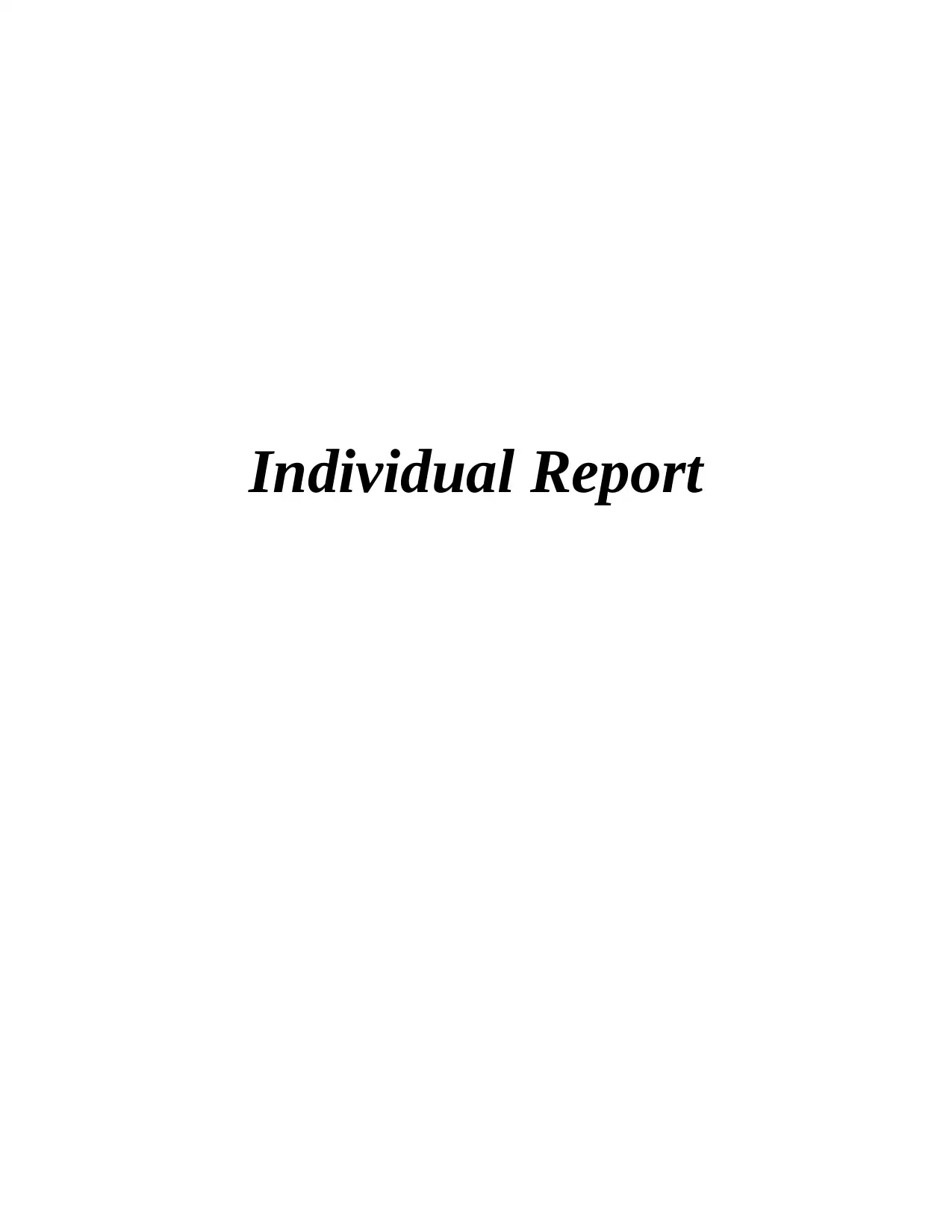
Individual Report
Secure Best Marks with AI Grader
Need help grading? Try our AI Grader for instant feedback on your assignments.
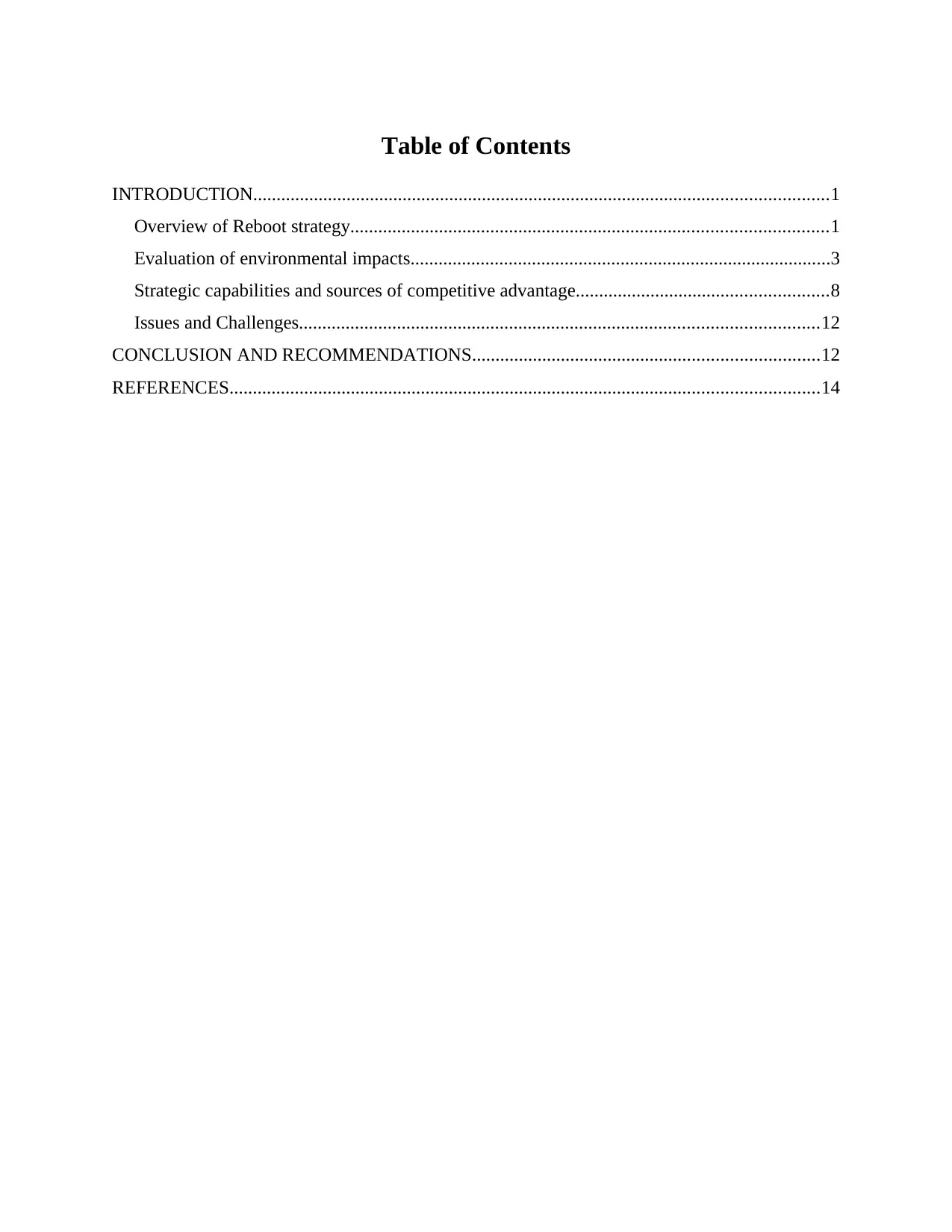
Table of Contents
INTRODUCTION...........................................................................................................................1
Overview of Reboot strategy......................................................................................................1
Evaluation of environmental impacts..........................................................................................3
Strategic capabilities and sources of competitive advantage......................................................8
Issues and Challenges...............................................................................................................12
CONCLUSION AND RECOMMENDATIONS..........................................................................12
REFERENCES..............................................................................................................................14
INTRODUCTION...........................................................................................................................1
Overview of Reboot strategy......................................................................................................1
Evaluation of environmental impacts..........................................................................................3
Strategic capabilities and sources of competitive advantage......................................................8
Issues and Challenges...............................................................................................................12
CONCLUSION AND RECOMMENDATIONS..........................................................................12
REFERENCES..............................................................................................................................14
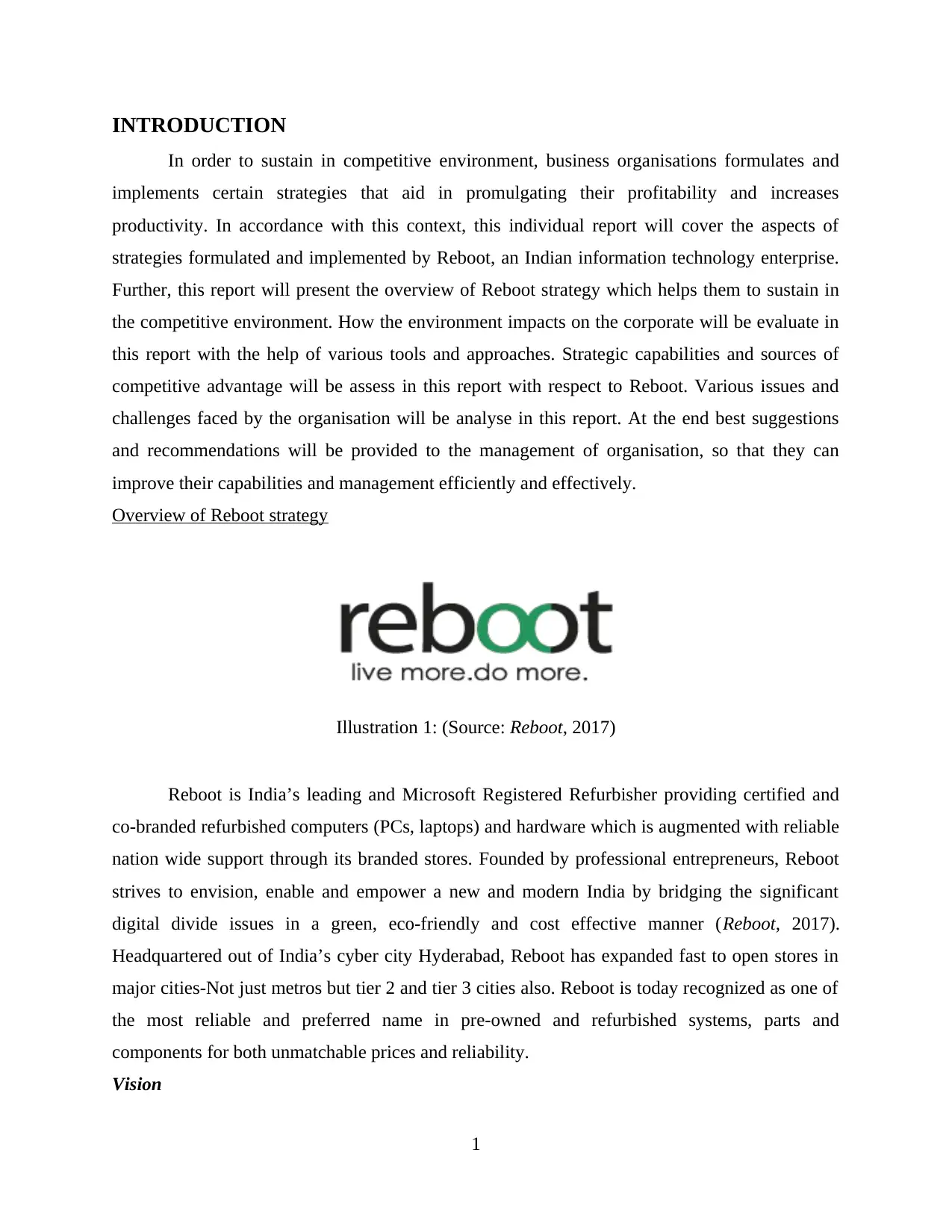
INTRODUCTION
In order to sustain in competitive environment, business organisations formulates and
implements certain strategies that aid in promulgating their profitability and increases
productivity. In accordance with this context, this individual report will cover the aspects of
strategies formulated and implemented by Reboot, an Indian information technology enterprise.
Further, this report will present the overview of Reboot strategy which helps them to sustain in
the competitive environment. How the environment impacts on the corporate will be evaluate in
this report with the help of various tools and approaches. Strategic capabilities and sources of
competitive advantage will be assess in this report with respect to Reboot. Various issues and
challenges faced by the organisation will be analyse in this report. At the end best suggestions
and recommendations will be provided to the management of organisation, so that they can
improve their capabilities and management efficiently and effectively.
Overview of Reboot strategy
Reboot is India’s leading and Microsoft Registered Refurbisher providing certified and
co-branded refurbished computers (PCs, laptops) and hardware which is augmented with reliable
nation wide support through its branded stores. Founded by professional entrepreneurs, Reboot
strives to envision, enable and empower a new and modern India by bridging the significant
digital divide issues in a green, eco-friendly and cost effective manner (Reboot, 2017).
Headquartered out of India’s cyber city Hyderabad, Reboot has expanded fast to open stores in
major cities-Not just metros but tier 2 and tier 3 cities also. Reboot is today recognized as one of
the most reliable and preferred name in pre-owned and refurbished systems, parts and
components for both unmatchable prices and reliability.
Vision
1
Illustration 1: (Source: Reboot, 2017)
In order to sustain in competitive environment, business organisations formulates and
implements certain strategies that aid in promulgating their profitability and increases
productivity. In accordance with this context, this individual report will cover the aspects of
strategies formulated and implemented by Reboot, an Indian information technology enterprise.
Further, this report will present the overview of Reboot strategy which helps them to sustain in
the competitive environment. How the environment impacts on the corporate will be evaluate in
this report with the help of various tools and approaches. Strategic capabilities and sources of
competitive advantage will be assess in this report with respect to Reboot. Various issues and
challenges faced by the organisation will be analyse in this report. At the end best suggestions
and recommendations will be provided to the management of organisation, so that they can
improve their capabilities and management efficiently and effectively.
Overview of Reboot strategy
Reboot is India’s leading and Microsoft Registered Refurbisher providing certified and
co-branded refurbished computers (PCs, laptops) and hardware which is augmented with reliable
nation wide support through its branded stores. Founded by professional entrepreneurs, Reboot
strives to envision, enable and empower a new and modern India by bridging the significant
digital divide issues in a green, eco-friendly and cost effective manner (Reboot, 2017).
Headquartered out of India’s cyber city Hyderabad, Reboot has expanded fast to open stores in
major cities-Not just metros but tier 2 and tier 3 cities also. Reboot is today recognized as one of
the most reliable and preferred name in pre-owned and refurbished systems, parts and
components for both unmatchable prices and reliability.
Vision
1
Illustration 1: (Source: Reboot, 2017)
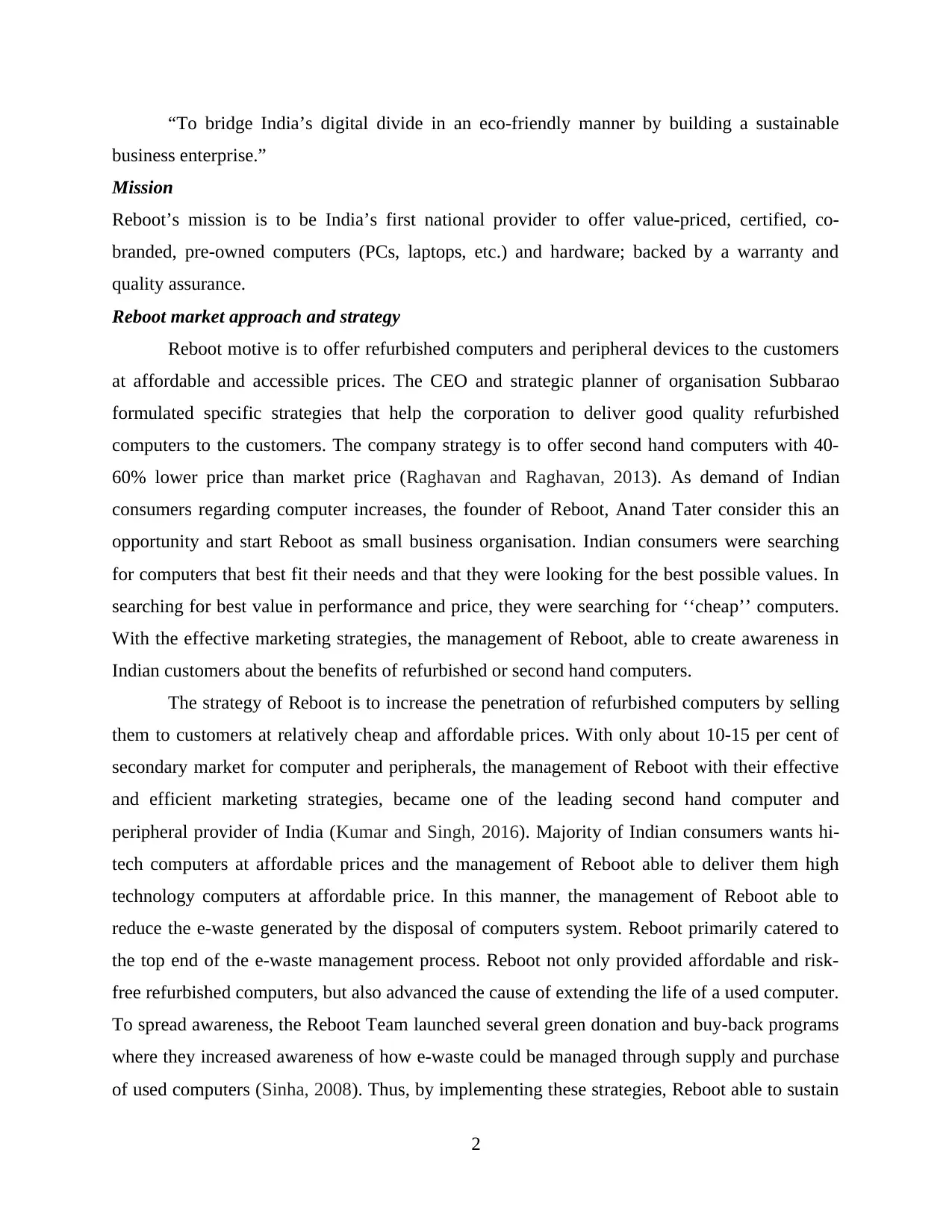
“To bridge India’s digital divide in an eco-friendly manner by building a sustainable
business enterprise.”
Mission
Reboot’s mission is to be India’s first national provider to offer value-priced, certified, co-
branded, pre-owned computers (PCs, laptops, etc.) and hardware; backed by a warranty and
quality assurance.
Reboot market approach and strategy
Reboot motive is to offer refurbished computers and peripheral devices to the customers
at affordable and accessible prices. The CEO and strategic planner of organisation Subbarao
formulated specific strategies that help the corporation to deliver good quality refurbished
computers to the customers. The company strategy is to offer second hand computers with 40-
60% lower price than market price (Raghavan and Raghavan, 2013). As demand of Indian
consumers regarding computer increases, the founder of Reboot, Anand Tater consider this an
opportunity and start Reboot as small business organisation. Indian consumers were searching
for computers that best fit their needs and that they were looking for the best possible values. In
searching for best value in performance and price, they were searching for ‘‘cheap’’ computers.
With the effective marketing strategies, the management of Reboot, able to create awareness in
Indian customers about the benefits of refurbished or second hand computers.
The strategy of Reboot is to increase the penetration of refurbished computers by selling
them to customers at relatively cheap and affordable prices. With only about 10-15 per cent of
secondary market for computer and peripherals, the management of Reboot with their effective
and efficient marketing strategies, became one of the leading second hand computer and
peripheral provider of India (Kumar and Singh, 2016). Majority of Indian consumers wants hi-
tech computers at affordable prices and the management of Reboot able to deliver them high
technology computers at affordable price. In this manner, the management of Reboot able to
reduce the e-waste generated by the disposal of computers system. Reboot primarily catered to
the top end of the e-waste management process. Reboot not only provided affordable and risk-
free refurbished computers, but also advanced the cause of extending the life of a used computer.
To spread awareness, the Reboot Team launched several green donation and buy-back programs
where they increased awareness of how e-waste could be managed through supply and purchase
of used computers (Sinha, 2008). Thus, by implementing these strategies, Reboot able to sustain
2
business enterprise.”
Mission
Reboot’s mission is to be India’s first national provider to offer value-priced, certified, co-
branded, pre-owned computers (PCs, laptops, etc.) and hardware; backed by a warranty and
quality assurance.
Reboot market approach and strategy
Reboot motive is to offer refurbished computers and peripheral devices to the customers
at affordable and accessible prices. The CEO and strategic planner of organisation Subbarao
formulated specific strategies that help the corporation to deliver good quality refurbished
computers to the customers. The company strategy is to offer second hand computers with 40-
60% lower price than market price (Raghavan and Raghavan, 2013). As demand of Indian
consumers regarding computer increases, the founder of Reboot, Anand Tater consider this an
opportunity and start Reboot as small business organisation. Indian consumers were searching
for computers that best fit their needs and that they were looking for the best possible values. In
searching for best value in performance and price, they were searching for ‘‘cheap’’ computers.
With the effective marketing strategies, the management of Reboot, able to create awareness in
Indian customers about the benefits of refurbished or second hand computers.
The strategy of Reboot is to increase the penetration of refurbished computers by selling
them to customers at relatively cheap and affordable prices. With only about 10-15 per cent of
secondary market for computer and peripherals, the management of Reboot with their effective
and efficient marketing strategies, became one of the leading second hand computer and
peripheral provider of India (Kumar and Singh, 2016). Majority of Indian consumers wants hi-
tech computers at affordable prices and the management of Reboot able to deliver them high
technology computers at affordable price. In this manner, the management of Reboot able to
reduce the e-waste generated by the disposal of computers system. Reboot primarily catered to
the top end of the e-waste management process. Reboot not only provided affordable and risk-
free refurbished computers, but also advanced the cause of extending the life of a used computer.
To spread awareness, the Reboot Team launched several green donation and buy-back programs
where they increased awareness of how e-waste could be managed through supply and purchase
of used computers (Sinha, 2008). Thus, by implementing these strategies, Reboot able to sustain
2
Secure Best Marks with AI Grader
Need help grading? Try our AI Grader for instant feedback on your assignments.
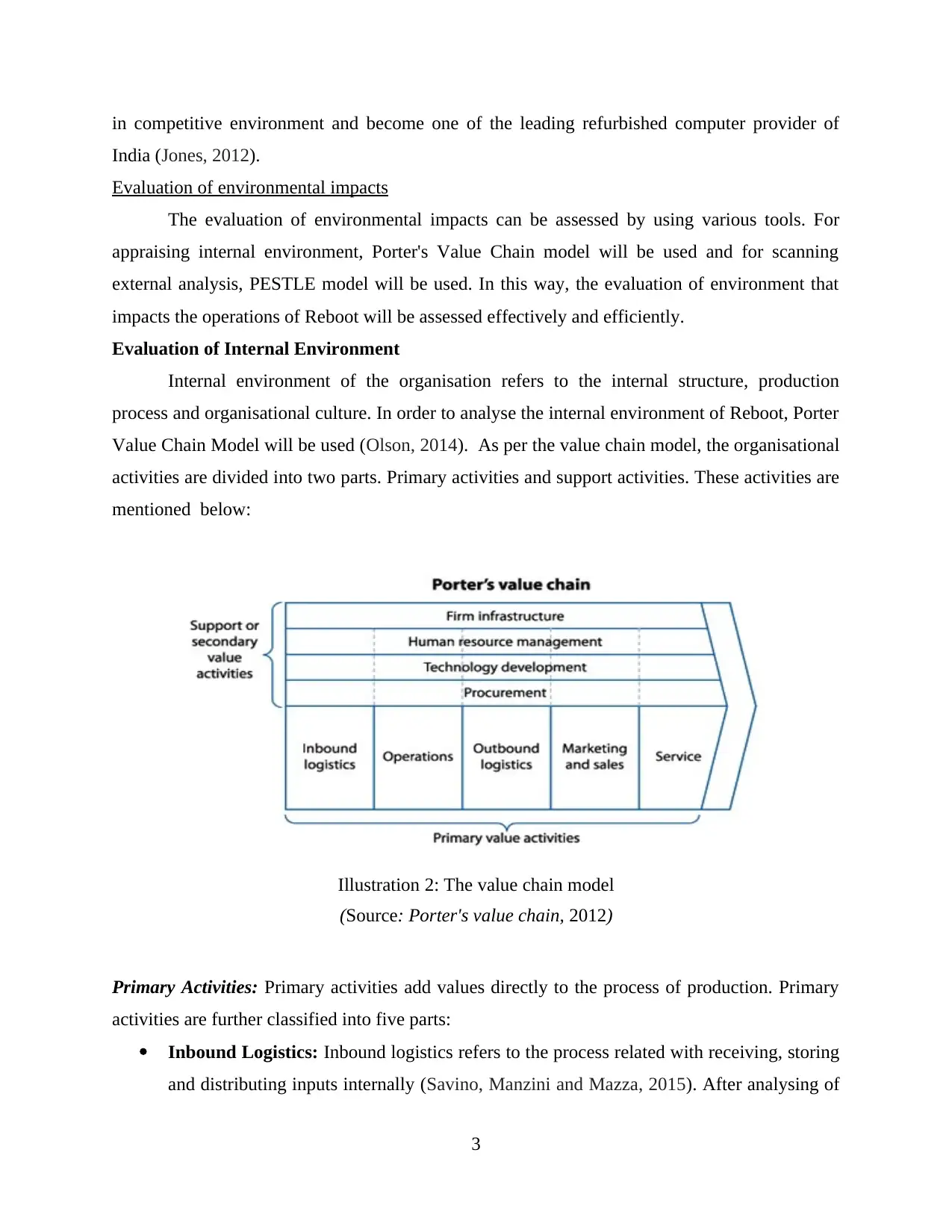
in competitive environment and become one of the leading refurbished computer provider of
India (Jones, 2012).
Evaluation of environmental impacts
The evaluation of environmental impacts can be assessed by using various tools. For
appraising internal environment, Porter's Value Chain model will be used and for scanning
external analysis, PESTLE model will be used. In this way, the evaluation of environment that
impacts the operations of Reboot will be assessed effectively and efficiently.
Evaluation of Internal Environment
Internal environment of the organisation refers to the internal structure, production
process and organisational culture. In order to analyse the internal environment of Reboot, Porter
Value Chain Model will be used (Olson, 2014). As per the value chain model, the organisational
activities are divided into two parts. Primary activities and support activities. These activities are
mentioned below:
Primary Activities: Primary activities add values directly to the process of production. Primary
activities are further classified into five parts:
Inbound Logistics: Inbound logistics refers to the process related with receiving, storing
and distributing inputs internally (Savino, Manzini and Mazza, 2015). After analysing of
3
Illustration 2: The value chain model
(Source: Porter's value chain, 2012)
India (Jones, 2012).
Evaluation of environmental impacts
The evaluation of environmental impacts can be assessed by using various tools. For
appraising internal environment, Porter's Value Chain model will be used and for scanning
external analysis, PESTLE model will be used. In this way, the evaluation of environment that
impacts the operations of Reboot will be assessed effectively and efficiently.
Evaluation of Internal Environment
Internal environment of the organisation refers to the internal structure, production
process and organisational culture. In order to analyse the internal environment of Reboot, Porter
Value Chain Model will be used (Olson, 2014). As per the value chain model, the organisational
activities are divided into two parts. Primary activities and support activities. These activities are
mentioned below:
Primary Activities: Primary activities add values directly to the process of production. Primary
activities are further classified into five parts:
Inbound Logistics: Inbound logistics refers to the process related with receiving, storing
and distributing inputs internally (Savino, Manzini and Mazza, 2015). After analysing of
3
Illustration 2: The value chain model
(Source: Porter's value chain, 2012)
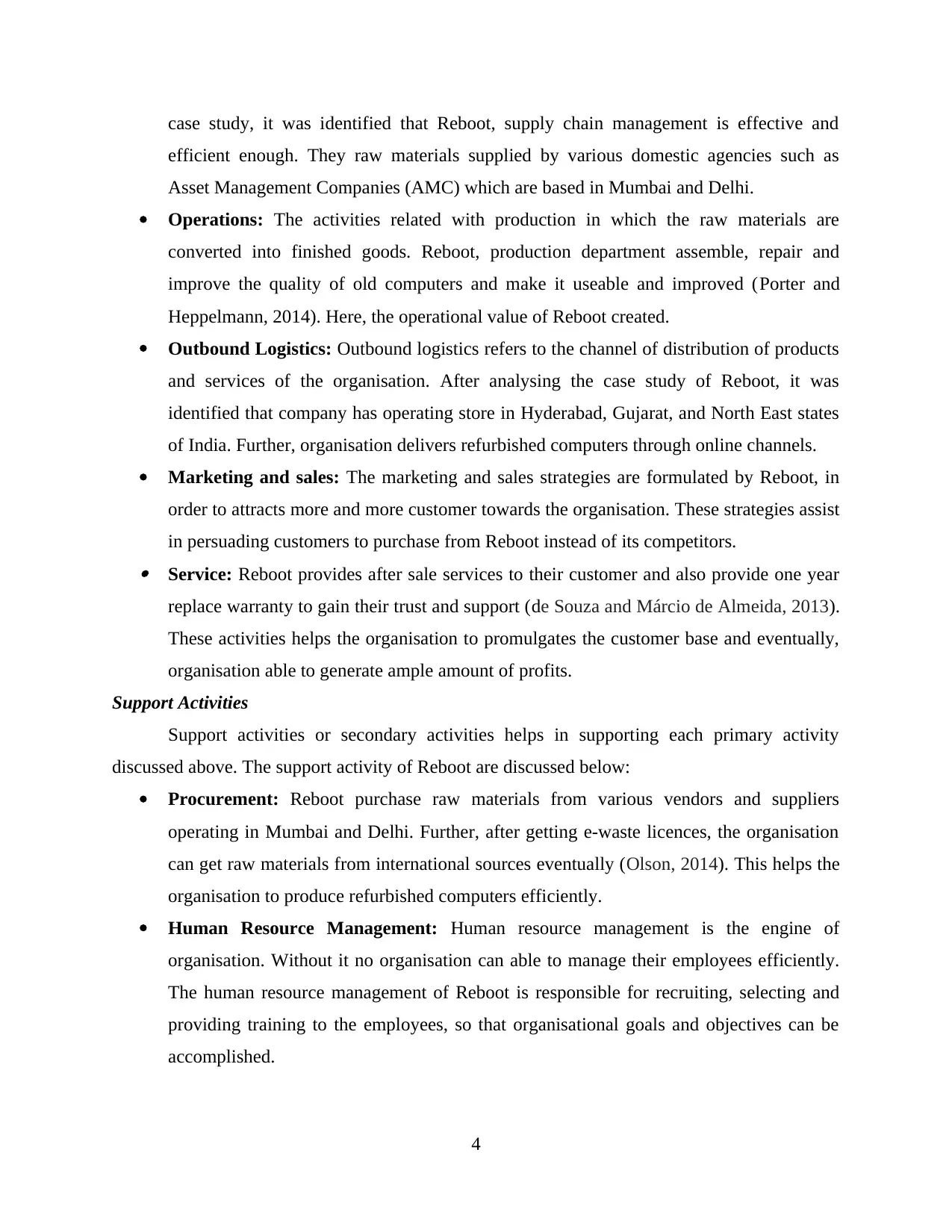
case study, it was identified that Reboot, supply chain management is effective and
efficient enough. They raw materials supplied by various domestic agencies such as
Asset Management Companies (AMC) which are based in Mumbai and Delhi.
Operations: The activities related with production in which the raw materials are
converted into finished goods. Reboot, production department assemble, repair and
improve the quality of old computers and make it useable and improved (Porter and
Heppelmann, 2014). Here, the operational value of Reboot created.
Outbound Logistics: Outbound logistics refers to the channel of distribution of products
and services of the organisation. After analysing the case study of Reboot, it was
identified that company has operating store in Hyderabad, Gujarat, and North East states
of India. Further, organisation delivers refurbished computers through online channels.
Marketing and sales: The marketing and sales strategies are formulated by Reboot, in
order to attracts more and more customer towards the organisation. These strategies assist
in persuading customers to purchase from Reboot instead of its competitors. Service: Reboot provides after sale services to their customer and also provide one year
replace warranty to gain their trust and support (de Souza and Márcio de Almeida, 2013).
These activities helps the organisation to promulgates the customer base and eventually,
organisation able to generate ample amount of profits.
Support Activities
Support activities or secondary activities helps in supporting each primary activity
discussed above. The support activity of Reboot are discussed below:
Procurement: Reboot purchase raw materials from various vendors and suppliers
operating in Mumbai and Delhi. Further, after getting e-waste licences, the organisation
can get raw materials from international sources eventually (Olson, 2014). This helps the
organisation to produce refurbished computers efficiently.
Human Resource Management: Human resource management is the engine of
organisation. Without it no organisation can able to manage their employees efficiently.
The human resource management of Reboot is responsible for recruiting, selecting and
providing training to the employees, so that organisational goals and objectives can be
accomplished.
4
efficient enough. They raw materials supplied by various domestic agencies such as
Asset Management Companies (AMC) which are based in Mumbai and Delhi.
Operations: The activities related with production in which the raw materials are
converted into finished goods. Reboot, production department assemble, repair and
improve the quality of old computers and make it useable and improved (Porter and
Heppelmann, 2014). Here, the operational value of Reboot created.
Outbound Logistics: Outbound logistics refers to the channel of distribution of products
and services of the organisation. After analysing the case study of Reboot, it was
identified that company has operating store in Hyderabad, Gujarat, and North East states
of India. Further, organisation delivers refurbished computers through online channels.
Marketing and sales: The marketing and sales strategies are formulated by Reboot, in
order to attracts more and more customer towards the organisation. These strategies assist
in persuading customers to purchase from Reboot instead of its competitors. Service: Reboot provides after sale services to their customer and also provide one year
replace warranty to gain their trust and support (de Souza and Márcio de Almeida, 2013).
These activities helps the organisation to promulgates the customer base and eventually,
organisation able to generate ample amount of profits.
Support Activities
Support activities or secondary activities helps in supporting each primary activity
discussed above. The support activity of Reboot are discussed below:
Procurement: Reboot purchase raw materials from various vendors and suppliers
operating in Mumbai and Delhi. Further, after getting e-waste licences, the organisation
can get raw materials from international sources eventually (Olson, 2014). This helps the
organisation to produce refurbished computers efficiently.
Human Resource Management: Human resource management is the engine of
organisation. Without it no organisation can able to manage their employees efficiently.
The human resource management of Reboot is responsible for recruiting, selecting and
providing training to the employees, so that organisational goals and objectives can be
accomplished.
4
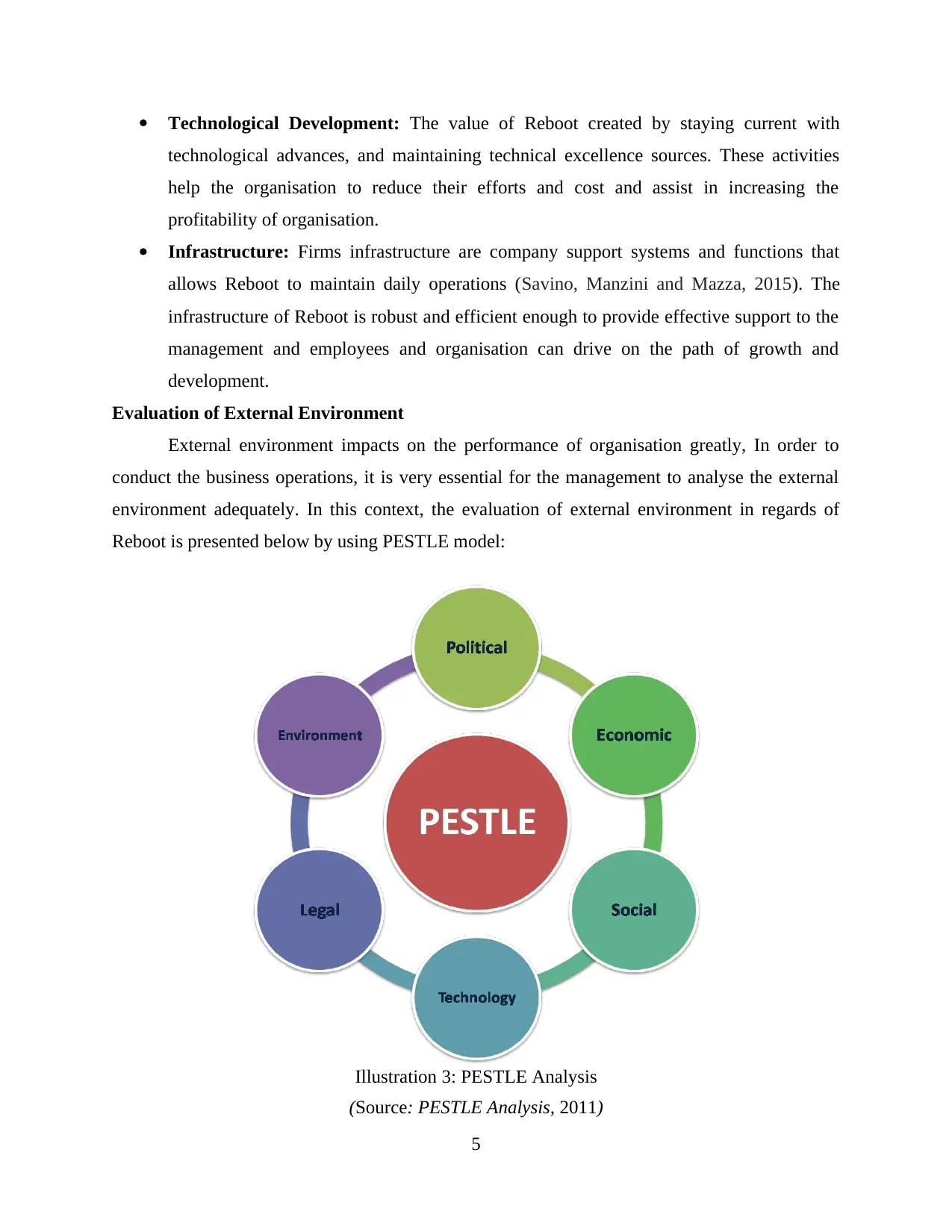
Technological Development: The value of Reboot created by staying current with
technological advances, and maintaining technical excellence sources. These activities
help the organisation to reduce their efforts and cost and assist in increasing the
profitability of organisation.
Infrastructure: Firms infrastructure are company support systems and functions that
allows Reboot to maintain daily operations (Savino, Manzini and Mazza, 2015). The
infrastructure of Reboot is robust and efficient enough to provide effective support to the
management and employees and organisation can drive on the path of growth and
development.
Evaluation of External Environment
External environment impacts on the performance of organisation greatly, In order to
conduct the business operations, it is very essential for the management to analyse the external
environment adequately. In this context, the evaluation of external environment in regards of
Reboot is presented below by using PESTLE model:
5
Illustration 3: PESTLE Analysis
(Source: PESTLE Analysis, 2011)
technological advances, and maintaining technical excellence sources. These activities
help the organisation to reduce their efforts and cost and assist in increasing the
profitability of organisation.
Infrastructure: Firms infrastructure are company support systems and functions that
allows Reboot to maintain daily operations (Savino, Manzini and Mazza, 2015). The
infrastructure of Reboot is robust and efficient enough to provide effective support to the
management and employees and organisation can drive on the path of growth and
development.
Evaluation of External Environment
External environment impacts on the performance of organisation greatly, In order to
conduct the business operations, it is very essential for the management to analyse the external
environment adequately. In this context, the evaluation of external environment in regards of
Reboot is presented below by using PESTLE model:
5
Illustration 3: PESTLE Analysis
(Source: PESTLE Analysis, 2011)
Paraphrase This Document
Need a fresh take? Get an instant paraphrase of this document with our AI Paraphraser
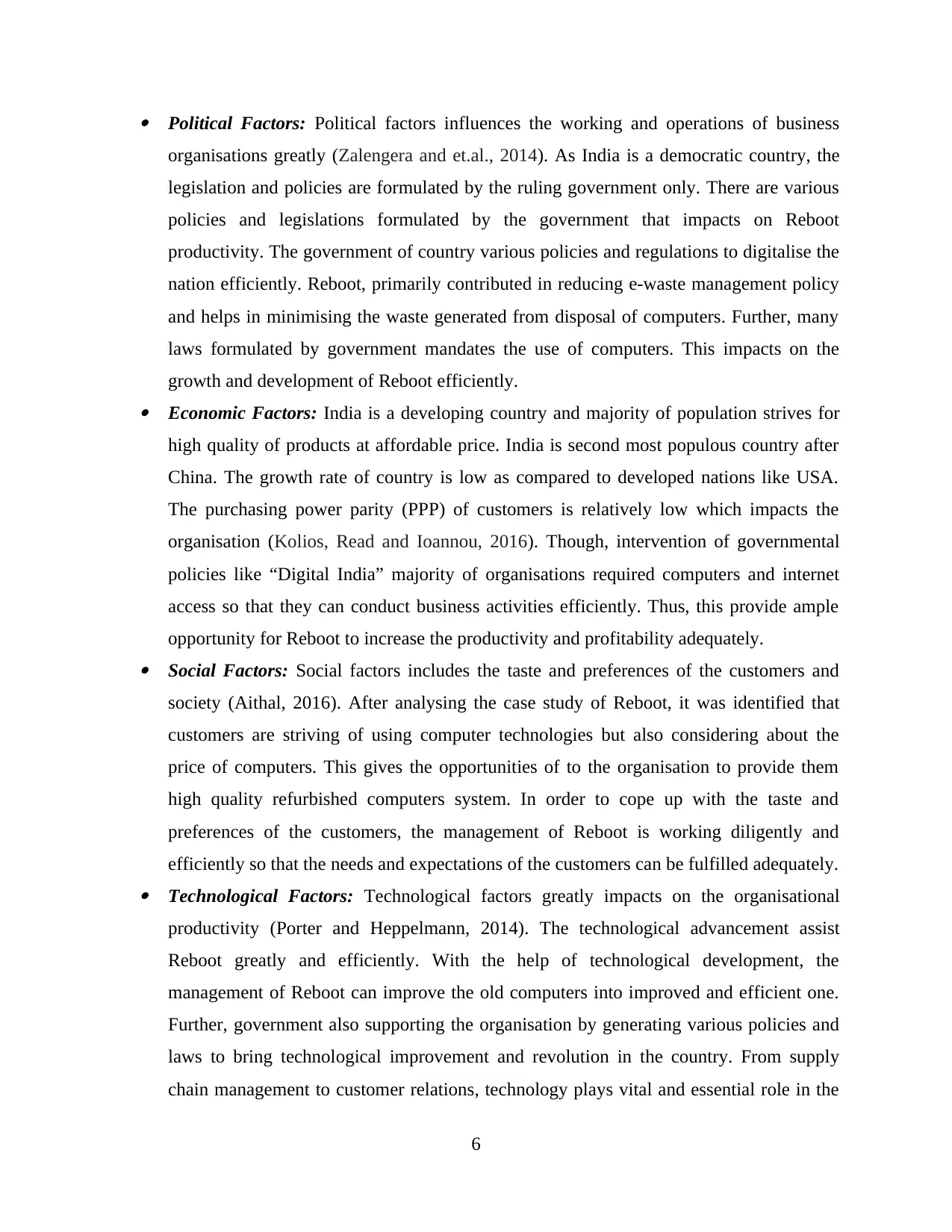
Political Factors: Political factors influences the working and operations of business
organisations greatly (Zalengera and et.al., 2014). As India is a democratic country, the
legislation and policies are formulated by the ruling government only. There are various
policies and legislations formulated by the government that impacts on Reboot
productivity. The government of country various policies and regulations to digitalise the
nation efficiently. Reboot, primarily contributed in reducing e-waste management policy
and helps in minimising the waste generated from disposal of computers. Further, many
laws formulated by government mandates the use of computers. This impacts on the
growth and development of Reboot efficiently. Economic Factors: India is a developing country and majority of population strives for
high quality of products at affordable price. India is second most populous country after
China. The growth rate of country is low as compared to developed nations like USA.
The purchasing power parity (PPP) of customers is relatively low which impacts the
organisation (Kolios, Read and Ioannou, 2016). Though, intervention of governmental
policies like “Digital India” majority of organisations required computers and internet
access so that they can conduct business activities efficiently. Thus, this provide ample
opportunity for Reboot to increase the productivity and profitability adequately. Social Factors: Social factors includes the taste and preferences of the customers and
society (Aithal, 2016). After analysing the case study of Reboot, it was identified that
customers are striving of using computer technologies but also considering about the
price of computers. This gives the opportunities of to the organisation to provide them
high quality refurbished computers system. In order to cope up with the taste and
preferences of the customers, the management of Reboot is working diligently and
efficiently so that the needs and expectations of the customers can be fulfilled adequately. Technological Factors: Technological factors greatly impacts on the organisational
productivity (Porter and Heppelmann, 2014). The technological advancement assist
Reboot greatly and efficiently. With the help of technological development, the
management of Reboot can improve the old computers into improved and efficient one.
Further, government also supporting the organisation by generating various policies and
laws to bring technological improvement and revolution in the country. From supply
chain management to customer relations, technology plays vital and essential role in the
6
organisations greatly (Zalengera and et.al., 2014). As India is a democratic country, the
legislation and policies are formulated by the ruling government only. There are various
policies and legislations formulated by the government that impacts on Reboot
productivity. The government of country various policies and regulations to digitalise the
nation efficiently. Reboot, primarily contributed in reducing e-waste management policy
and helps in minimising the waste generated from disposal of computers. Further, many
laws formulated by government mandates the use of computers. This impacts on the
growth and development of Reboot efficiently. Economic Factors: India is a developing country and majority of population strives for
high quality of products at affordable price. India is second most populous country after
China. The growth rate of country is low as compared to developed nations like USA.
The purchasing power parity (PPP) of customers is relatively low which impacts the
organisation (Kolios, Read and Ioannou, 2016). Though, intervention of governmental
policies like “Digital India” majority of organisations required computers and internet
access so that they can conduct business activities efficiently. Thus, this provide ample
opportunity for Reboot to increase the productivity and profitability adequately. Social Factors: Social factors includes the taste and preferences of the customers and
society (Aithal, 2016). After analysing the case study of Reboot, it was identified that
customers are striving of using computer technologies but also considering about the
price of computers. This gives the opportunities of to the organisation to provide them
high quality refurbished computers system. In order to cope up with the taste and
preferences of the customers, the management of Reboot is working diligently and
efficiently so that the needs and expectations of the customers can be fulfilled adequately. Technological Factors: Technological factors greatly impacts on the organisational
productivity (Porter and Heppelmann, 2014). The technological advancement assist
Reboot greatly and efficiently. With the help of technological development, the
management of Reboot can improve the old computers into improved and efficient one.
Further, government also supporting the organisation by generating various policies and
laws to bring technological improvement and revolution in the country. From supply
chain management to customer relations, technology plays vital and essential role in the
6
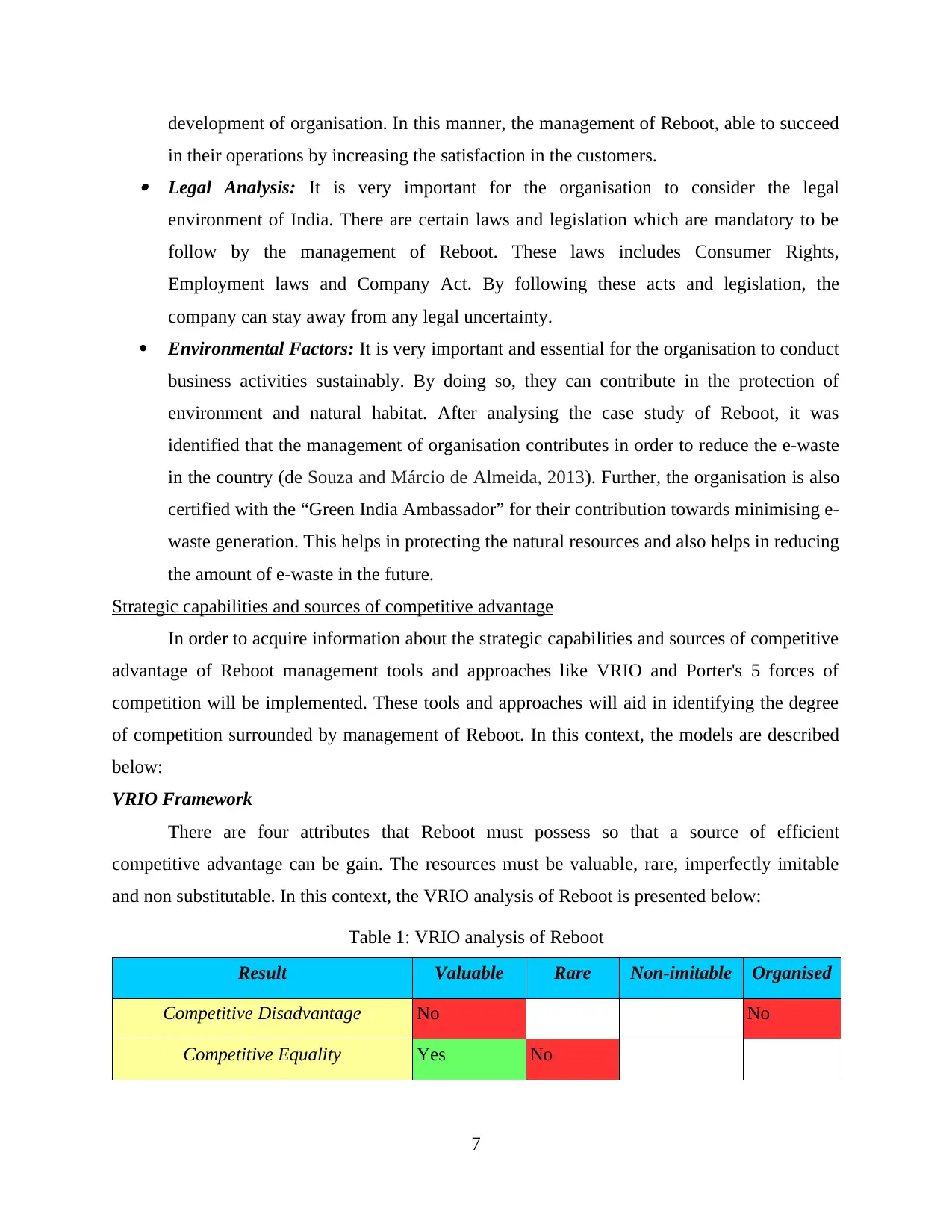
development of organisation. In this manner, the management of Reboot, able to succeed
in their operations by increasing the satisfaction in the customers. Legal Analysis: It is very important for the organisation to consider the legal
environment of India. There are certain laws and legislation which are mandatory to be
follow by the management of Reboot. These laws includes Consumer Rights,
Employment laws and Company Act. By following these acts and legislation, the
company can stay away from any legal uncertainty.
Environmental Factors: It is very important and essential for the organisation to conduct
business activities sustainably. By doing so, they can contribute in the protection of
environment and natural habitat. After analysing the case study of Reboot, it was
identified that the management of organisation contributes in order to reduce the e-waste
in the country (de Souza and Márcio de Almeida, 2013). Further, the organisation is also
certified with the “Green India Ambassador” for their contribution towards minimising e-
waste generation. This helps in protecting the natural resources and also helps in reducing
the amount of e-waste in the future.
Strategic capabilities and sources of competitive advantage
In order to acquire information about the strategic capabilities and sources of competitive
advantage of Reboot management tools and approaches like VRIO and Porter's 5 forces of
competition will be implemented. These tools and approaches will aid in identifying the degree
of competition surrounded by management of Reboot. In this context, the models are described
below:
VRIO Framework
There are four attributes that Reboot must possess so that a source of efficient
competitive advantage can be gain. The resources must be valuable, rare, imperfectly imitable
and non substitutable. In this context, the VRIO analysis of Reboot is presented below:
Table 1: VRIO analysis of Reboot
Result Valuable Rare Non-imitable Organised
Competitive Disadvantage No No
Competitive Equality Yes No
7
in their operations by increasing the satisfaction in the customers. Legal Analysis: It is very important for the organisation to consider the legal
environment of India. There are certain laws and legislation which are mandatory to be
follow by the management of Reboot. These laws includes Consumer Rights,
Employment laws and Company Act. By following these acts and legislation, the
company can stay away from any legal uncertainty.
Environmental Factors: It is very important and essential for the organisation to conduct
business activities sustainably. By doing so, they can contribute in the protection of
environment and natural habitat. After analysing the case study of Reboot, it was
identified that the management of organisation contributes in order to reduce the e-waste
in the country (de Souza and Márcio de Almeida, 2013). Further, the organisation is also
certified with the “Green India Ambassador” for their contribution towards minimising e-
waste generation. This helps in protecting the natural resources and also helps in reducing
the amount of e-waste in the future.
Strategic capabilities and sources of competitive advantage
In order to acquire information about the strategic capabilities and sources of competitive
advantage of Reboot management tools and approaches like VRIO and Porter's 5 forces of
competition will be implemented. These tools and approaches will aid in identifying the degree
of competition surrounded by management of Reboot. In this context, the models are described
below:
VRIO Framework
There are four attributes that Reboot must possess so that a source of efficient
competitive advantage can be gain. The resources must be valuable, rare, imperfectly imitable
and non substitutable. In this context, the VRIO analysis of Reboot is presented below:
Table 1: VRIO analysis of Reboot
Result Valuable Rare Non-imitable Organised
Competitive Disadvantage No No
Competitive Equality Yes No
7
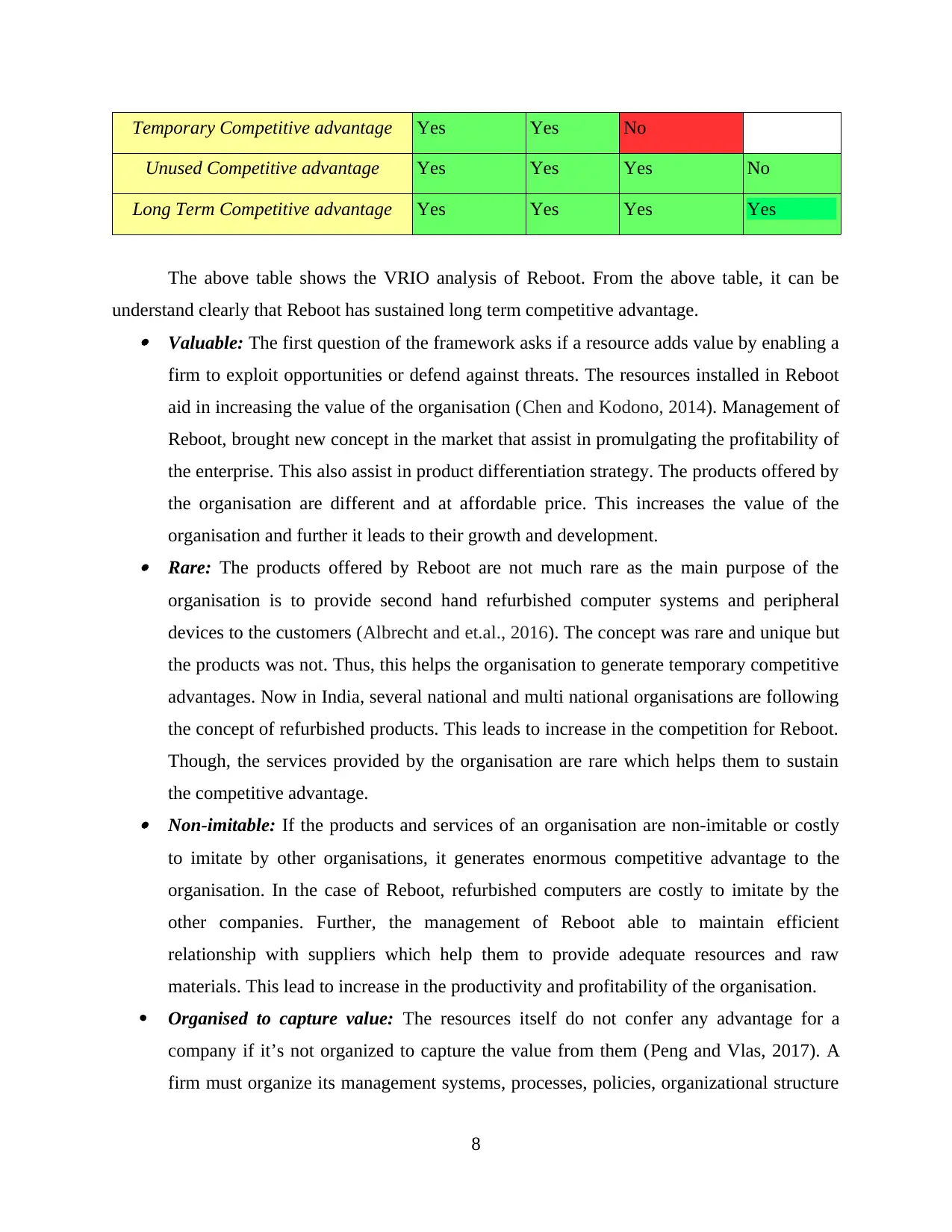
Temporary Competitive advantage Yes Yes No
Unused Competitive advantage Yes Yes Yes No
Long Term Competitive advantage Yes Yes Yes Yes
The above table shows the VRIO analysis of Reboot. From the above table, it can be
understand clearly that Reboot has sustained long term competitive advantage. Valuable: The first question of the framework asks if a resource adds value by enabling a
firm to exploit opportunities or defend against threats. The resources installed in Reboot
aid in increasing the value of the organisation (Chen and Kodono, 2014). Management of
Reboot, brought new concept in the market that assist in promulgating the profitability of
the enterprise. This also assist in product differentiation strategy. The products offered by
the organisation are different and at affordable price. This increases the value of the
organisation and further it leads to their growth and development. Rare: The products offered by Reboot are not much rare as the main purpose of the
organisation is to provide second hand refurbished computer systems and peripheral
devices to the customers (Albrecht and et.al., 2016). The concept was rare and unique but
the products was not. Thus, this helps the organisation to generate temporary competitive
advantages. Now in India, several national and multi national organisations are following
the concept of refurbished products. This leads to increase in the competition for Reboot.
Though, the services provided by the organisation are rare which helps them to sustain
the competitive advantage. Non-imitable: If the products and services of an organisation are non-imitable or costly
to imitate by other organisations, it generates enormous competitive advantage to the
organisation. In the case of Reboot, refurbished computers are costly to imitate by the
other companies. Further, the management of Reboot able to maintain efficient
relationship with suppliers which help them to provide adequate resources and raw
materials. This lead to increase in the productivity and profitability of the organisation.
Organised to capture value: The resources itself do not confer any advantage for a
company if it’s not organized to capture the value from them (Peng and Vlas, 2017). A
firm must organize its management systems, processes, policies, organizational structure
8
Unused Competitive advantage Yes Yes Yes No
Long Term Competitive advantage Yes Yes Yes Yes
The above table shows the VRIO analysis of Reboot. From the above table, it can be
understand clearly that Reboot has sustained long term competitive advantage. Valuable: The first question of the framework asks if a resource adds value by enabling a
firm to exploit opportunities or defend against threats. The resources installed in Reboot
aid in increasing the value of the organisation (Chen and Kodono, 2014). Management of
Reboot, brought new concept in the market that assist in promulgating the profitability of
the enterprise. This also assist in product differentiation strategy. The products offered by
the organisation are different and at affordable price. This increases the value of the
organisation and further it leads to their growth and development. Rare: The products offered by Reboot are not much rare as the main purpose of the
organisation is to provide second hand refurbished computer systems and peripheral
devices to the customers (Albrecht and et.al., 2016). The concept was rare and unique but
the products was not. Thus, this helps the organisation to generate temporary competitive
advantages. Now in India, several national and multi national organisations are following
the concept of refurbished products. This leads to increase in the competition for Reboot.
Though, the services provided by the organisation are rare which helps them to sustain
the competitive advantage. Non-imitable: If the products and services of an organisation are non-imitable or costly
to imitate by other organisations, it generates enormous competitive advantage to the
organisation. In the case of Reboot, refurbished computers are costly to imitate by the
other companies. Further, the management of Reboot able to maintain efficient
relationship with suppliers which help them to provide adequate resources and raw
materials. This lead to increase in the productivity and profitability of the organisation.
Organised to capture value: The resources itself do not confer any advantage for a
company if it’s not organized to capture the value from them (Peng and Vlas, 2017). A
firm must organize its management systems, processes, policies, organizational structure
8
Secure Best Marks with AI Grader
Need help grading? Try our AI Grader for instant feedback on your assignments.
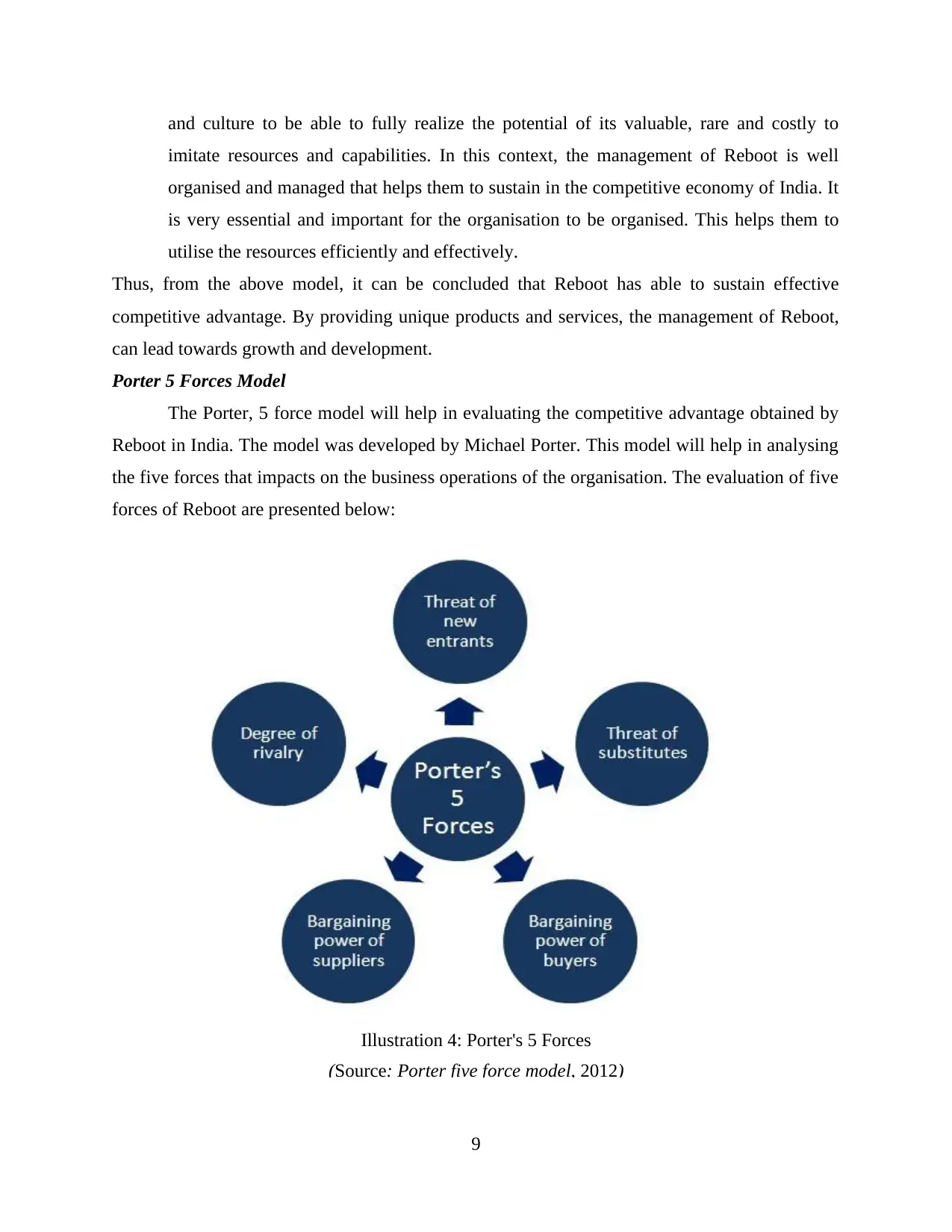
and culture to be able to fully realize the potential of its valuable, rare and costly to
imitate resources and capabilities. In this context, the management of Reboot is well
organised and managed that helps them to sustain in the competitive economy of India. It
is very essential and important for the organisation to be organised. This helps them to
utilise the resources efficiently and effectively.
Thus, from the above model, it can be concluded that Reboot has able to sustain effective
competitive advantage. By providing unique products and services, the management of Reboot,
can lead towards growth and development.
Porter 5 Forces Model
The Porter, 5 force model will help in evaluating the competitive advantage obtained by
Reboot in India. The model was developed by Michael Porter. This model will help in analysing
the five forces that impacts on the business operations of the organisation. The evaluation of five
forces of Reboot are presented below:
9
Illustration 4: Porter's 5 Forces
(Source: Porter five force model, 2012)
imitate resources and capabilities. In this context, the management of Reboot is well
organised and managed that helps them to sustain in the competitive economy of India. It
is very essential and important for the organisation to be organised. This helps them to
utilise the resources efficiently and effectively.
Thus, from the above model, it can be concluded that Reboot has able to sustain effective
competitive advantage. By providing unique products and services, the management of Reboot,
can lead towards growth and development.
Porter 5 Forces Model
The Porter, 5 force model will help in evaluating the competitive advantage obtained by
Reboot in India. The model was developed by Michael Porter. This model will help in analysing
the five forces that impacts on the business operations of the organisation. The evaluation of five
forces of Reboot are presented below:
9
Illustration 4: Porter's 5 Forces
(Source: Porter five force model, 2012)
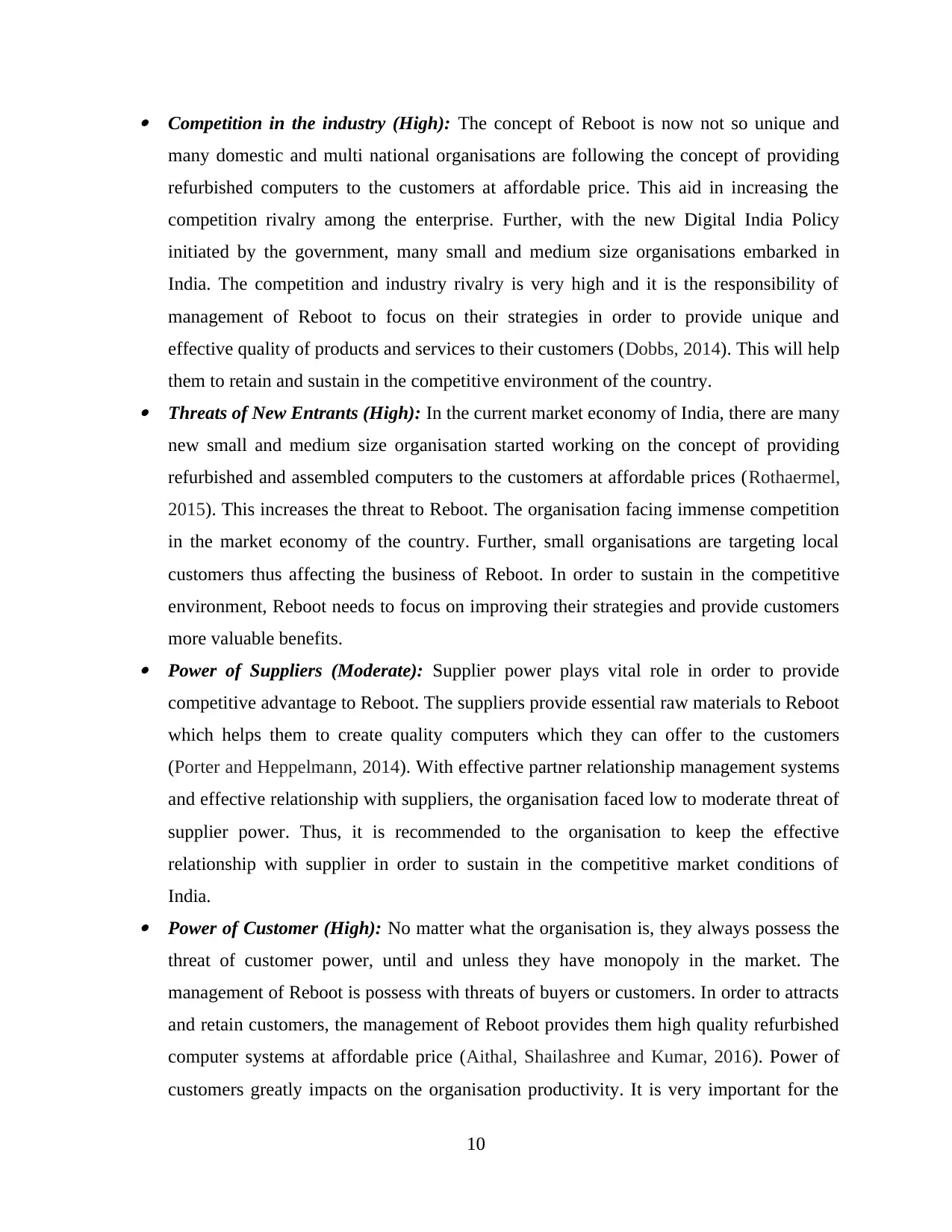
Competition in the industry (High): The concept of Reboot is now not so unique and
many domestic and multi national organisations are following the concept of providing
refurbished computers to the customers at affordable price. This aid in increasing the
competition rivalry among the enterprise. Further, with the new Digital India Policy
initiated by the government, many small and medium size organisations embarked in
India. The competition and industry rivalry is very high and it is the responsibility of
management of Reboot to focus on their strategies in order to provide unique and
effective quality of products and services to their customers (Dobbs, 2014). This will help
them to retain and sustain in the competitive environment of the country. Threats of New Entrants (High): In the current market economy of India, there are many
new small and medium size organisation started working on the concept of providing
refurbished and assembled computers to the customers at affordable prices (Rothaermel,
2015). This increases the threat to Reboot. The organisation facing immense competition
in the market economy of the country. Further, small organisations are targeting local
customers thus affecting the business of Reboot. In order to sustain in the competitive
environment, Reboot needs to focus on improving their strategies and provide customers
more valuable benefits. Power of Suppliers (Moderate): Supplier power plays vital role in order to provide
competitive advantage to Reboot. The suppliers provide essential raw materials to Reboot
which helps them to create quality computers which they can offer to the customers
(Porter and Heppelmann, 2014). With effective partner relationship management systems
and effective relationship with suppliers, the organisation faced low to moderate threat of
supplier power. Thus, it is recommended to the organisation to keep the effective
relationship with supplier in order to sustain in the competitive market conditions of
India. Power of Customer (High): No matter what the organisation is, they always possess the
threat of customer power, until and unless they have monopoly in the market. The
management of Reboot is possess with threats of buyers or customers. In order to attracts
and retain customers, the management of Reboot provides them high quality refurbished
computer systems at affordable price (Aithal, Shailashree and Kumar, 2016). Power of
customers greatly impacts on the organisation productivity. It is very important for the
10
many domestic and multi national organisations are following the concept of providing
refurbished computers to the customers at affordable price. This aid in increasing the
competition rivalry among the enterprise. Further, with the new Digital India Policy
initiated by the government, many small and medium size organisations embarked in
India. The competition and industry rivalry is very high and it is the responsibility of
management of Reboot to focus on their strategies in order to provide unique and
effective quality of products and services to their customers (Dobbs, 2014). This will help
them to retain and sustain in the competitive environment of the country. Threats of New Entrants (High): In the current market economy of India, there are many
new small and medium size organisation started working on the concept of providing
refurbished and assembled computers to the customers at affordable prices (Rothaermel,
2015). This increases the threat to Reboot. The organisation facing immense competition
in the market economy of the country. Further, small organisations are targeting local
customers thus affecting the business of Reboot. In order to sustain in the competitive
environment, Reboot needs to focus on improving their strategies and provide customers
more valuable benefits. Power of Suppliers (Moderate): Supplier power plays vital role in order to provide
competitive advantage to Reboot. The suppliers provide essential raw materials to Reboot
which helps them to create quality computers which they can offer to the customers
(Porter and Heppelmann, 2014). With effective partner relationship management systems
and effective relationship with suppliers, the organisation faced low to moderate threat of
supplier power. Thus, it is recommended to the organisation to keep the effective
relationship with supplier in order to sustain in the competitive market conditions of
India. Power of Customer (High): No matter what the organisation is, they always possess the
threat of customer power, until and unless they have monopoly in the market. The
management of Reboot is possess with threats of buyers or customers. In order to attracts
and retain customers, the management of Reboot provides them high quality refurbished
computer systems at affordable price (Aithal, Shailashree and Kumar, 2016). Power of
customers greatly impacts on the organisation productivity. It is very important for the
10
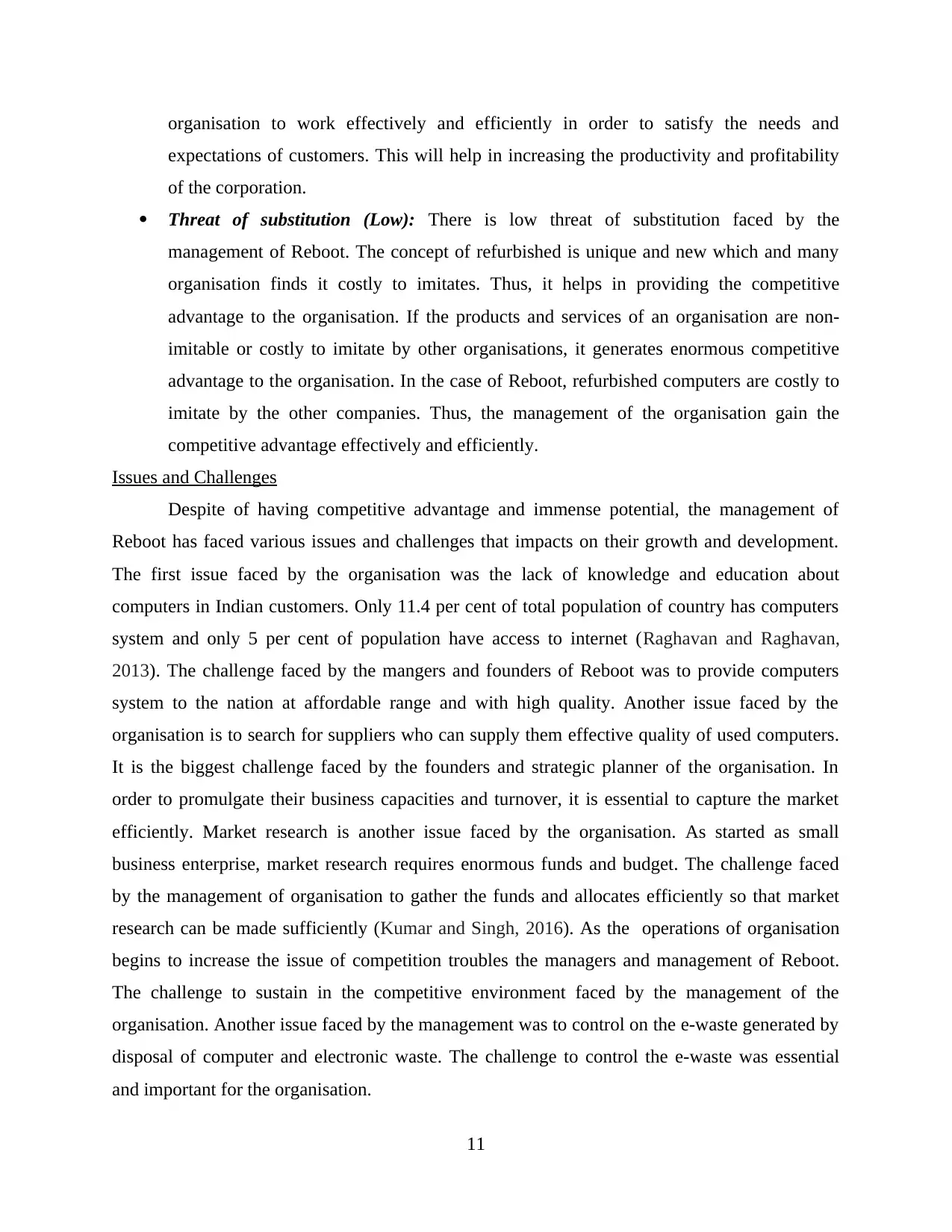
organisation to work effectively and efficiently in order to satisfy the needs and
expectations of customers. This will help in increasing the productivity and profitability
of the corporation.
Threat of substitution (Low): There is low threat of substitution faced by the
management of Reboot. The concept of refurbished is unique and new which and many
organisation finds it costly to imitates. Thus, it helps in providing the competitive
advantage to the organisation. If the products and services of an organisation are non-
imitable or costly to imitate by other organisations, it generates enormous competitive
advantage to the organisation. In the case of Reboot, refurbished computers are costly to
imitate by the other companies. Thus, the management of the organisation gain the
competitive advantage effectively and efficiently.
Issues and Challenges
Despite of having competitive advantage and immense potential, the management of
Reboot has faced various issues and challenges that impacts on their growth and development.
The first issue faced by the organisation was the lack of knowledge and education about
computers in Indian customers. Only 11.4 per cent of total population of country has computers
system and only 5 per cent of population have access to internet (Raghavan and Raghavan,
2013). The challenge faced by the mangers and founders of Reboot was to provide computers
system to the nation at affordable range and with high quality. Another issue faced by the
organisation is to search for suppliers who can supply them effective quality of used computers.
It is the biggest challenge faced by the founders and strategic planner of the organisation. In
order to promulgate their business capacities and turnover, it is essential to capture the market
efficiently. Market research is another issue faced by the organisation. As started as small
business enterprise, market research requires enormous funds and budget. The challenge faced
by the management of organisation to gather the funds and allocates efficiently so that market
research can be made sufficiently (Kumar and Singh, 2016). As the operations of organisation
begins to increase the issue of competition troubles the managers and management of Reboot.
The challenge to sustain in the competitive environment faced by the management of the
organisation. Another issue faced by the management was to control on the e-waste generated by
disposal of computer and electronic waste. The challenge to control the e-waste was essential
and important for the organisation.
11
expectations of customers. This will help in increasing the productivity and profitability
of the corporation.
Threat of substitution (Low): There is low threat of substitution faced by the
management of Reboot. The concept of refurbished is unique and new which and many
organisation finds it costly to imitates. Thus, it helps in providing the competitive
advantage to the organisation. If the products and services of an organisation are non-
imitable or costly to imitate by other organisations, it generates enormous competitive
advantage to the organisation. In the case of Reboot, refurbished computers are costly to
imitate by the other companies. Thus, the management of the organisation gain the
competitive advantage effectively and efficiently.
Issues and Challenges
Despite of having competitive advantage and immense potential, the management of
Reboot has faced various issues and challenges that impacts on their growth and development.
The first issue faced by the organisation was the lack of knowledge and education about
computers in Indian customers. Only 11.4 per cent of total population of country has computers
system and only 5 per cent of population have access to internet (Raghavan and Raghavan,
2013). The challenge faced by the mangers and founders of Reboot was to provide computers
system to the nation at affordable range and with high quality. Another issue faced by the
organisation is to search for suppliers who can supply them effective quality of used computers.
It is the biggest challenge faced by the founders and strategic planner of the organisation. In
order to promulgate their business capacities and turnover, it is essential to capture the market
efficiently. Market research is another issue faced by the organisation. As started as small
business enterprise, market research requires enormous funds and budget. The challenge faced
by the management of organisation to gather the funds and allocates efficiently so that market
research can be made sufficiently (Kumar and Singh, 2016). As the operations of organisation
begins to increase the issue of competition troubles the managers and management of Reboot.
The challenge to sustain in the competitive environment faced by the management of the
organisation. Another issue faced by the management was to control on the e-waste generated by
disposal of computer and electronic waste. The challenge to control the e-waste was essential
and important for the organisation.
11
Paraphrase This Document
Need a fresh take? Get an instant paraphrase of this document with our AI Paraphraser
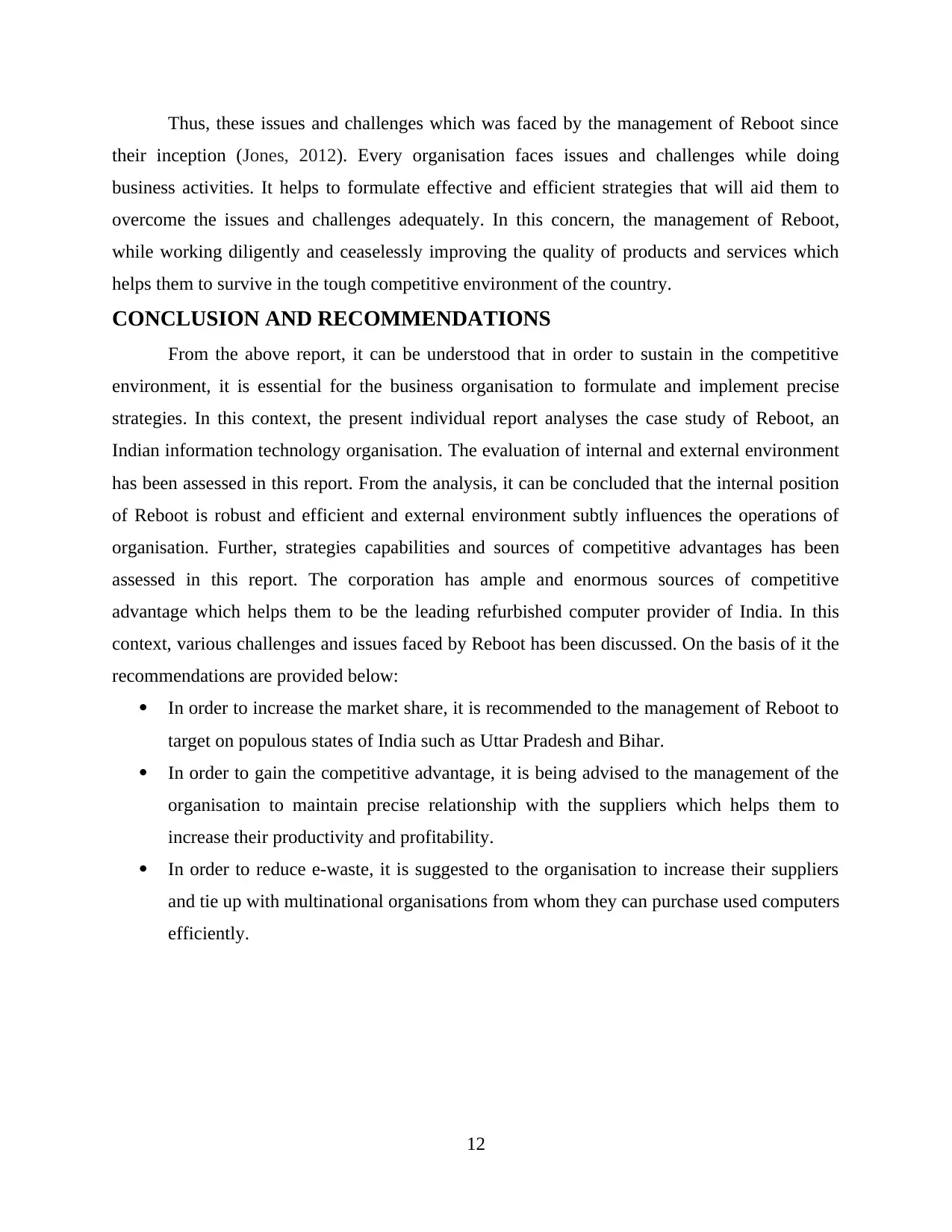
Thus, these issues and challenges which was faced by the management of Reboot since
their inception (Jones, 2012). Every organisation faces issues and challenges while doing
business activities. It helps to formulate effective and efficient strategies that will aid them to
overcome the issues and challenges adequately. In this concern, the management of Reboot,
while working diligently and ceaselessly improving the quality of products and services which
helps them to survive in the tough competitive environment of the country.
CONCLUSION AND RECOMMENDATIONS
From the above report, it can be understood that in order to sustain in the competitive
environment, it is essential for the business organisation to formulate and implement precise
strategies. In this context, the present individual report analyses the case study of Reboot, an
Indian information technology organisation. The evaluation of internal and external environment
has been assessed in this report. From the analysis, it can be concluded that the internal position
of Reboot is robust and efficient and external environment subtly influences the operations of
organisation. Further, strategies capabilities and sources of competitive advantages has been
assessed in this report. The corporation has ample and enormous sources of competitive
advantage which helps them to be the leading refurbished computer provider of India. In this
context, various challenges and issues faced by Reboot has been discussed. On the basis of it the
recommendations are provided below:
In order to increase the market share, it is recommended to the management of Reboot to
target on populous states of India such as Uttar Pradesh and Bihar.
In order to gain the competitive advantage, it is being advised to the management of the
organisation to maintain precise relationship with the suppliers which helps them to
increase their productivity and profitability.
In order to reduce e-waste, it is suggested to the organisation to increase their suppliers
and tie up with multinational organisations from whom they can purchase used computers
efficiently.
12
their inception (Jones, 2012). Every organisation faces issues and challenges while doing
business activities. It helps to formulate effective and efficient strategies that will aid them to
overcome the issues and challenges adequately. In this concern, the management of Reboot,
while working diligently and ceaselessly improving the quality of products and services which
helps them to survive in the tough competitive environment of the country.
CONCLUSION AND RECOMMENDATIONS
From the above report, it can be understood that in order to sustain in the competitive
environment, it is essential for the business organisation to formulate and implement precise
strategies. In this context, the present individual report analyses the case study of Reboot, an
Indian information technology organisation. The evaluation of internal and external environment
has been assessed in this report. From the analysis, it can be concluded that the internal position
of Reboot is robust and efficient and external environment subtly influences the operations of
organisation. Further, strategies capabilities and sources of competitive advantages has been
assessed in this report. The corporation has ample and enormous sources of competitive
advantage which helps them to be the leading refurbished computer provider of India. In this
context, various challenges and issues faced by Reboot has been discussed. On the basis of it the
recommendations are provided below:
In order to increase the market share, it is recommended to the management of Reboot to
target on populous states of India such as Uttar Pradesh and Bihar.
In order to gain the competitive advantage, it is being advised to the management of the
organisation to maintain precise relationship with the suppliers which helps them to
increase their productivity and profitability.
In order to reduce e-waste, it is suggested to the organisation to increase their suppliers
and tie up with multinational organisations from whom they can purchase used computers
efficiently.
12
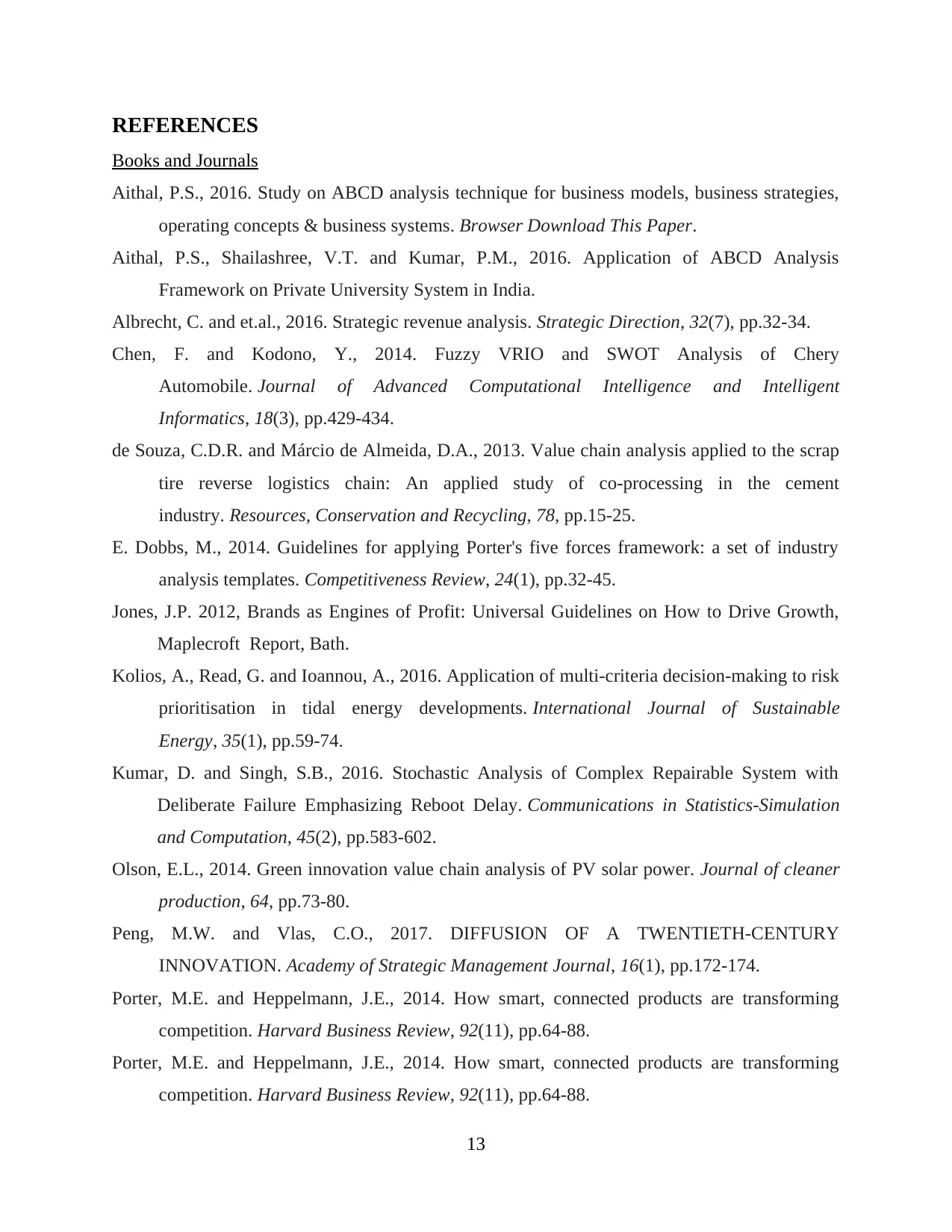
REFERENCES
Books and Journals
Aithal, P.S., 2016. Study on ABCD analysis technique for business models, business strategies,
operating concepts & business systems. Browser Download This Paper.
Aithal, P.S., Shailashree, V.T. and Kumar, P.M., 2016. Application of ABCD Analysis
Framework on Private University System in India.
Albrecht, C. and et.al., 2016. Strategic revenue analysis. Strategic Direction, 32(7), pp.32-34.
Chen, F. and Kodono, Y., 2014. Fuzzy VRIO and SWOT Analysis of Chery
Automobile. Journal of Advanced Computational Intelligence and Intelligent
Informatics, 18(3), pp.429-434.
de Souza, C.D.R. and Márcio de Almeida, D.A., 2013. Value chain analysis applied to the scrap
tire reverse logistics chain: An applied study of co-processing in the cement
industry. Resources, Conservation and Recycling, 78, pp.15-25.
E. Dobbs, M., 2014. Guidelines for applying Porter's five forces framework: a set of industry
analysis templates. Competitiveness Review, 24(1), pp.32-45.
Jones, J.P. 2012, Brands as Engines of Profit: Universal Guidelines on How to Drive Growth,
Maplecroft Report, Bath.
Kolios, A., Read, G. and Ioannou, A., 2016. Application of multi-criteria decision-making to risk
prioritisation in tidal energy developments. International Journal of Sustainable
Energy, 35(1), pp.59-74.
Kumar, D. and Singh, S.B., 2016. Stochastic Analysis of Complex Repairable System with
Deliberate Failure Emphasizing Reboot Delay. Communications in Statistics-Simulation
and Computation, 45(2), pp.583-602.
Olson, E.L., 2014. Green innovation value chain analysis of PV solar power. Journal of cleaner
production, 64, pp.73-80.
Peng, M.W. and Vlas, C.O., 2017. DIFFUSION OF A TWENTIETH-CENTURY
INNOVATION. Academy of Strategic Management Journal, 16(1), pp.172-174.
Porter, M.E. and Heppelmann, J.E., 2014. How smart, connected products are transforming
competition. Harvard Business Review, 92(11), pp.64-88.
Porter, M.E. and Heppelmann, J.E., 2014. How smart, connected products are transforming
competition. Harvard Business Review, 92(11), pp.64-88.
13
Books and Journals
Aithal, P.S., 2016. Study on ABCD analysis technique for business models, business strategies,
operating concepts & business systems. Browser Download This Paper.
Aithal, P.S., Shailashree, V.T. and Kumar, P.M., 2016. Application of ABCD Analysis
Framework on Private University System in India.
Albrecht, C. and et.al., 2016. Strategic revenue analysis. Strategic Direction, 32(7), pp.32-34.
Chen, F. and Kodono, Y., 2014. Fuzzy VRIO and SWOT Analysis of Chery
Automobile. Journal of Advanced Computational Intelligence and Intelligent
Informatics, 18(3), pp.429-434.
de Souza, C.D.R. and Márcio de Almeida, D.A., 2013. Value chain analysis applied to the scrap
tire reverse logistics chain: An applied study of co-processing in the cement
industry. Resources, Conservation and Recycling, 78, pp.15-25.
E. Dobbs, M., 2014. Guidelines for applying Porter's five forces framework: a set of industry
analysis templates. Competitiveness Review, 24(1), pp.32-45.
Jones, J.P. 2012, Brands as Engines of Profit: Universal Guidelines on How to Drive Growth,
Maplecroft Report, Bath.
Kolios, A., Read, G. and Ioannou, A., 2016. Application of multi-criteria decision-making to risk
prioritisation in tidal energy developments. International Journal of Sustainable
Energy, 35(1), pp.59-74.
Kumar, D. and Singh, S.B., 2016. Stochastic Analysis of Complex Repairable System with
Deliberate Failure Emphasizing Reboot Delay. Communications in Statistics-Simulation
and Computation, 45(2), pp.583-602.
Olson, E.L., 2014. Green innovation value chain analysis of PV solar power. Journal of cleaner
production, 64, pp.73-80.
Peng, M.W. and Vlas, C.O., 2017. DIFFUSION OF A TWENTIETH-CENTURY
INNOVATION. Academy of Strategic Management Journal, 16(1), pp.172-174.
Porter, M.E. and Heppelmann, J.E., 2014. How smart, connected products are transforming
competition. Harvard Business Review, 92(11), pp.64-88.
Porter, M.E. and Heppelmann, J.E., 2014. How smart, connected products are transforming
competition. Harvard Business Review, 92(11), pp.64-88.
13
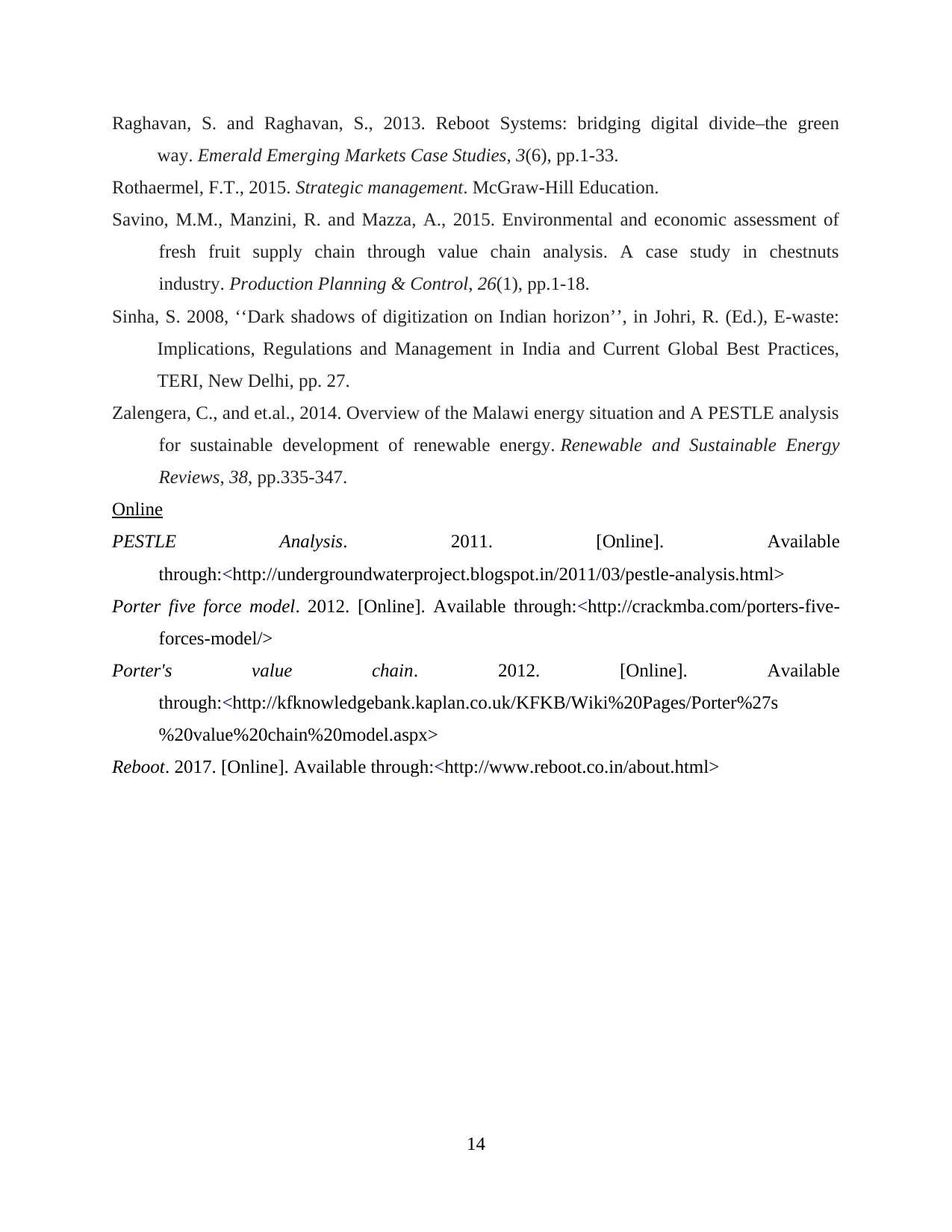
Raghavan, S. and Raghavan, S., 2013. Reboot Systems: bridging digital divide–the green
way. Emerald Emerging Markets Case Studies, 3(6), pp.1-33.
Rothaermel, F.T., 2015. Strategic management. McGraw-Hill Education.
Savino, M.M., Manzini, R. and Mazza, A., 2015. Environmental and economic assessment of
fresh fruit supply chain through value chain analysis. A case study in chestnuts
industry. Production Planning & Control, 26(1), pp.1-18.
Sinha, S. 2008, ‘‘Dark shadows of digitization on Indian horizon’’, in Johri, R. (Ed.), E-waste:
Implications, Regulations and Management in India and Current Global Best Practices,
TERI, New Delhi, pp. 27.
Zalengera, C., and et.al., 2014. Overview of the Malawi energy situation and A PESTLE analysis
for sustainable development of renewable energy. Renewable and Sustainable Energy
Reviews, 38, pp.335-347.
Online
PESTLE Analysis. 2011. [Online]. Available
through:<http://undergroundwaterproject.blogspot.in/2011/03/pestle-analysis.html>
Porter five force model. 2012. [Online]. Available through:<http://crackmba.com/porters-five-
forces-model/>
Porter's value chain. 2012. [Online]. Available
through:<http://kfknowledgebank.kaplan.co.uk/KFKB/Wiki%20Pages/Porter%27s
%20value%20chain%20model.aspx>
Reboot. 2017. [Online]. Available through:<http://www.reboot.co.in/about.html>
14
way. Emerald Emerging Markets Case Studies, 3(6), pp.1-33.
Rothaermel, F.T., 2015. Strategic management. McGraw-Hill Education.
Savino, M.M., Manzini, R. and Mazza, A., 2015. Environmental and economic assessment of
fresh fruit supply chain through value chain analysis. A case study in chestnuts
industry. Production Planning & Control, 26(1), pp.1-18.
Sinha, S. 2008, ‘‘Dark shadows of digitization on Indian horizon’’, in Johri, R. (Ed.), E-waste:
Implications, Regulations and Management in India and Current Global Best Practices,
TERI, New Delhi, pp. 27.
Zalengera, C., and et.al., 2014. Overview of the Malawi energy situation and A PESTLE analysis
for sustainable development of renewable energy. Renewable and Sustainable Energy
Reviews, 38, pp.335-347.
Online
PESTLE Analysis. 2011. [Online]. Available
through:<http://undergroundwaterproject.blogspot.in/2011/03/pestle-analysis.html>
Porter five force model. 2012. [Online]. Available through:<http://crackmba.com/porters-five-
forces-model/>
Porter's value chain. 2012. [Online]. Available
through:<http://kfknowledgebank.kaplan.co.uk/KFKB/Wiki%20Pages/Porter%27s
%20value%20chain%20model.aspx>
Reboot. 2017. [Online]. Available through:<http://www.reboot.co.in/about.html>
14
1 out of 16
Related Documents
Your All-in-One AI-Powered Toolkit for Academic Success.
+13062052269
info@desklib.com
Available 24*7 on WhatsApp / Email
![[object Object]](/_next/static/media/star-bottom.7253800d.svg)
Unlock your academic potential
© 2024 | Zucol Services PVT LTD | All rights reserved.
